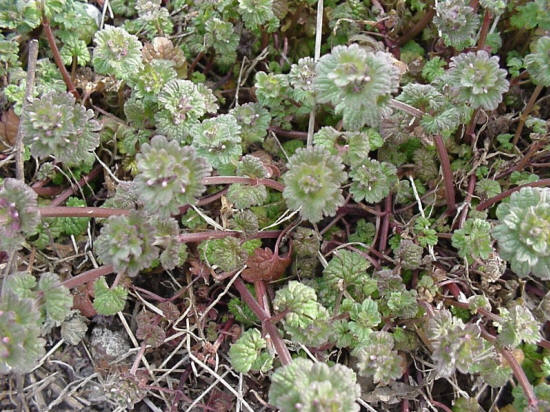|
 Column Column
Early Season Lawn Weeds, Fairy Rings,
Mushrooms, and Puffballs
By John Fulton
 Send a link to a friend
Send a link to a friend
[April 13, 2015]
Early Season Lawn Weeds - Each
year, the winter annual weeds chickweed and henbit run number one
and two in the early spring. This year, it seems the henbit has once
again regained the number one spot. Winter annual weeds can actually
germinate in the fall, carry through the winter, then get going very
early in the spring.
|
|
 They also are done by the heat of the summer, leaving seed to
germinate again later in the fall. Right now chickweed stands
out in yards because it is quite abundant, and has a lighter
green color than grass and most other weeds. It is also
beginning to set seed. There are two types: common chickweed and
mouse-ear chickweed. Henbit is easier to identify since it has
purple flowers and smells like mint. As for control, that gets a
bit easier. They also are done by the heat of the summer, leaving seed to
germinate again later in the fall. Right now chickweed stands
out in yards because it is quite abundant, and has a lighter
green color than grass and most other weeds. It is also
beginning to set seed. There are two types: common chickweed and
mouse-ear chickweed. Henbit is easier to identify since it has
purple flowers and smells like mint. As for control, that gets a
bit easier.
The straight 2,4-D that is used on dandelions seems to act like
a fertilizer for chickweed and other problem weeds. 2-4D is a
growth regulator, and if it doesn’t actually kill a weed it does
make it grow faster. Combinations that contain 2,4-D, MCPP, and
dicamba are rated very effective on chickweed, henbit, red
sorrel, purslane, white clover, and others. Triclopyr is a newer
herbicide found in some combinations, and is used for hard to
control broadleaf weeds and woody undesirables. Just remember
the control time for most broadleaf weeds is early May, but the
winter annuals are going strong now. These combinations are sold
under several different trade names. You can find these at most
hardware, discount, and lawn and garden stores. Just check the
label under active ingredients and check for two long chemical
names and dicamba. You can also check to see that it says it
will control chickweed and henbit. This group of chemicals is
effective in the 50 degree range and up. It just takes a lot
longer for control with very cool temperatures. As with any
chemical control, read and follow label instructions very
carefully. There will be some cautions on these product labels
concerning injury to sensitive plants that you should be aware
of. This is because dicamba can drift as a vapor for a few weeks
after you apply it if the weather gets hot and sunny.
Fairy Rings, Mushrooms, and Puffballs
Throughout the year I get several calls and samples brought in
dealing with puffballs or toadstools. Even this early in the
season, we have had calls about dark green grass in rings that
kind of looks like a target pattern. These rings are called
fairy rings, and they frequently have the puffballs or
toadstools growing in the area.
[to top of second column] |

Fairy rings are caused by a fungus that is in the soil. Actually
there are about 50 fungi that can cause fairy rings. These fungi
feed on decaying organic matter such as large roots from trees
that were in the area, or from buried lumber. The dark green
circle part of the equation comes from extra nitrogen that
becomes available as the organic matter is broken down by the
fungus.
Some prevention will help keep the problem from occurring. Simply
removing stumps, large roots, and not burying lumber help
prevent this type of problem. As for a cure, fungicide drenches
have been successful on a very limited basis. One popular option
is to mask the symptoms of the dark rings by fertilizing the
surrounding grass with a high-nitrogen fertilizer to make that
grass green also.

As for the puffballs, toadstools, or mushrooms, they are part of
the same complex as fairy rings. They are part of the natural
decay process that helps break down large wood items in the
ground. There is no real control so mowing them off or knocking
them loose with a garden rake is about the best thing going.
[By JOHN FULTON, COUNTY EXTENSION
DIRECTOR SERVING LOGAN, MENARD, AND SANGAMON COUNTIES] |